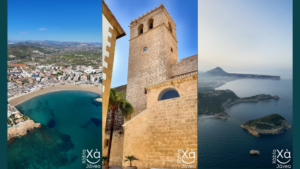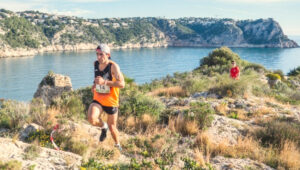87 new positive cases in Xàbia but cumulative rate drops
New infections remain high in the Marina Alta, taking the total number to 7,000 since the start of the pandemic.
This is the latest information on the status of the health situation in Xàbia, the Marina Alta, the Comunidad Valenciana and across Spain.
For more information, please refer to the links given at the bottom of the page as our report is based on the official figures given in these sources.
Xàbia
Xàbia has seen 87 new positive cases reported since the last update on Friday 22nd January, taking the total to 1,061 positive cases found in Xàbia since the pandemic began. The IA rate1 has dropped below 1,000, which is a move in the right direction.
Latest Data (24/01/2021)
14-Day Cumulative Rate (IA): 985.36 ↑
Positive PCR Tests in the past 14 days: 273 ↓
Total Positive Cases: 1,061
Total Deaths: 6
News
Police broke up a social gathering of more than 25 people on private land on Sunday. The group – who apparently came together from different municipalities in the Comunidad Valenciana – were playing volleyball and had set-up an area for food and drinks. An investigation has been opened.
Marina Alta
The Dénia Health Authority, which covers the Marina Alta region, has recorded 652 new infections since the last update, bringing the total to 7,008 positive cases since the crisis began.
There has been 9 new deaths since the last update, bringing the total to 101 since the crisis began.
Latest Data (24/01/2021)
14-Day Cumulative Rate (IA): 1,058.57 ↑
Positive PCR Tests in the past 14 days: 1,831 ↑
The 652 new infections have been recorded in the following municipalities:
- Dénia – 147 / 1 death
- Calp – 118 / 1 death
- Xàbia – 87
- Benissa – 84
- Teulada – 68
- Gata de Gorgos – 34 / 2 deaths
- Ondara – 27
- Pego – 25
- El Vergel – 18 / 4 deaths
- Pedreguer – 15
- Orba – 7
- Beniarbeig – 5
- Alcalalí – 4
- Els Poblets – 3
- Xaló – 3
- La Vall de Laguar – 2
- Parcent – 2
- Poble Nou de Benitatxell – 2
- Benimeli – 1
Vall de Gallinera remains the only municipality in the Marina Alta not to have recorded a single positive case.
Comunidad Valenciana
The 14-day IA rate for the Comunidad Valenciana is now 1339.67, an increase of over 150% in two weeks so it seems to be slowing down, whilst the positivity rate2 for the region has dropped slightly to 30.47%.
Latest IA Rate by Health Authority (24/01/2021)
↑ up on 14 days ago
↓ down on 14 days ago
3,036.10 – Alcoi ↑ 105%
2,193.57 – Elda ↑ 177%
1,881.12 – Elx ↑ 447%
1,752.06 – Xàtiva-Ontinyent ↑ 126%
1,565.67 – Valencia Dr.Peset ↑ 133%
1,451.03 – La Ribera ↑ 23%
1,433.32 – Requena ↑ 46%
1,426.06 – Manises ↑ 758%
1,416.49 – Valencia La Fe ↑ 168%
1,372.62 – Valencia Clinic La Malva Rosa ↑ 145%
1,369.80 – Vinaros ↑ 161%
1,357.53 – Sagunt ↑ 182%
1,281.59 – La Marina Baixa ↑ 251%
1,251.32 – Valencia Hospital General ↑ 178%
1,218.11 – La Plana ↑ 191%
1,160.41 – Sant Joan de l’Alacant ↑ 139%
1,152.84 – Alacant Hospital General ↑ 209%
1,104.77 – Elx-Crevillent ↑ 395%
1,058.57 – Dénia ↑ 33%
1,050.39 – Valencia Arnau de Vilanova-Llíria ↑ 209%
945.00 – Orihuela ↑ 212%
794.92 – Gandía ↑ 97%
791.46 – Castelló ↑ 137%
377.37 – Torrevieja ↑ 800%
The Data
Since the last update on 24/01/2021:
8,423 new cases of coronavirus have been confirmed through PCR or antigen tests; by province, the distribution of these new cases is 668 in Castellón, 3,218 in Valencia, and 4,537 in Alicante. In total, 246,392 positive cases have been recorded in the Comunidad Valenciana. There are 57 unassigned cases.
There have been a total of 29 new outbreaks across the Comunidad Valenciana; by province, the distribution is 5 in Castellón, 13 in Valencia, and 11 in Alicante (Benidorm, Crevillent, Ibi, L’Alfàs del Pi, La Nucia, Orihuela, Villajoyosa, and Villena; all have been designated as social in origin and affecting 63 people in total).
The data shows that the are currently 67,371 active cases of COVID-19 in the Comunidad Valenciana, with represents 24.42% of the total number of positives cases recorded.
There have been 96 deaths from COVID-19, bringing the total for the Comunidad Valenciana to 4,227 people; by province, the distribution of the deaths is 505 Castellón, 2,222 Valencia, and 1,500 Alicante.
There are 4,777 people in hospitals across the Comunidad Valenciana who are being treated for the COVID-19 infection; by province, the distribution is 459 Castellón with 46 patients in ICU, 2,467 Valencia with 337 in ICU, and 1,851 Alicante with 221 in ICU.
8,459 recoveries from COVID-19 have been registered; in total, 204,312 people in the Comunidad Valenciana have overcome the disease since the pandemic began.
105,041 doses of the vaccination have been administered throughout the Comunidad Valenciana, 102,433 Pfizer/BioNtech and 2,608 Modena.
News
Just a few days after closing bars and restaurants across the region, the Generalitat Valenciana issued even further measures to combat the spread of the virus which ban gatherings with those who don’t live together in private homes and limit to two people in public spaces whilst large cities will be confined to their perimeters during the weekends and bank holidays.
IN DETAIL – Decree 2/2021 New Restrictions in the Comunidad Valenciana, a full translation of the Presidential Decree 2/2021 on the new restrictions to limit movement and social interaction is available here.
Spain
The national 14-day IA rate is now 884.70. Spain has reported 93,822 new cases identified, the highest weekend figure since the pandemic began. However, Fernando Simón, director of the Health Ministry’s Coordination Centre for Health Alerts (CCAES), explained that it seems that the country is likely to have reached the peak of the third wave and the number of new cases is slowly falling.
Latest Data (25/01/2021)
(trend increase or decrease in 14 days)
Total Positive Cases: 2,593,382 (+481,600) ↑
Total Deaths: 56,208 (+3,922) ↑
Current Hospitalizations: 30,483 (+13,691) ↑
Current % of Hospital Beds occupied by COVID patients: 23,94% ↑
Current % of ICU Beds occupied by COVID patients: 40.38% ↑
Vaccination Data (23/01/2021)
Doses Available: 1,346,100 (1,310,145: Pfizer/BioNtech | 35,700: Moderna)
Doses Administered: 1,237,593 (91,90%)
Doses Completed: 88,698 (7.17%)
Latest IA Rate by Autonomous Region (25/01/2021)
↑ up on 14 days ago
↓ down on 14 days ago
1,381.37 – Extremadura ↑ 28%
1,371.91 – Murcía ↑ 391%
1,351.80 – Castilla y León ↑ 188%
1,339.67 – Comunidad Valenciana ↑ 137%
1,266.11 – La Rioja ↑ 113%
1,248.29 – Castilla-La Mancha ↑ 110%
971.24 – Melilla ↑ 131%
946.53 – Madrid ↑ 52%
915.28 – Andalucia ↑ 195%
751.01 – Aragón ↑ 82%
700.83 – Galicia ↑ 124%
689.98 – Baleares ↑ 15%
639.67 – Cataluña ↑ 22%
515.47 – Ceuta ↑ 46%
494.23 – Asturias ↑ 143%
471.56 – Navarra ↑ 56%
457.97 – País Vasco ↑ 66%
411.65 – Cantabria ↑ 35%
189.52 – Canarias ↑ 26%
News
“The enormous effort of spring 2020 has been wasted. Basic lessons were not learned.”
MIGUEL HERNÁN, PROFESSOR OF EPIDEMIOLOGY AT HARVARD UNIVERSITY
Spain continues to struggle to contain the third wave of COVID-19 infections as a more infectious strain takes hold across the country. The surge in new cases is pushing the health system to the limit and some regions are recording similar and even more admissions that the spring of last year. Fernando Simón, director of the Health Ministry’s Coordination Centre for Health Alerts (CCAES), warned that “our ICUs cannot take much more of what they are having to deal with” with average occupation on an ICU bed around 20-21 days, meaning that measures need to slow down new admissions and give the ICU wards some respite.
More than 20% of new cases in some areas have been identified as the new, more infectious strain that was first detected in the UK in December. Pere Godoy of the Spanish Epidemiology Society believes that priorities should be on detecting this new variant. “If this is not done, controlling it later is going to be much more complicated. It is an opportunity to establish an effective monitoring system that really controls these new variants. And we must not be satisfied with reducing transmission to levels of the second wave, because if we do, we could enter a fourth wave that is even worse.“
Epidemiologist Javier del Águila said: “We know that the virus responds to the measures that we take: if they are tough, the incidence rate and transmission fall. We are going to have to do what we know and accept that over Christmas [when restrictions were relaxed to allow family gatherings] we were wrong.“
According to the latest report by the Carlos III Health Institute, four in 10 people who tested positive for coronavirus do not know how they contracted the virus. In addition, Spain’s coronavirus tracking app has seemingly failed its purpose. Since its launch in September, 36,735 positive cases have been notified, less than 2% of the official number.
Data Explanation
1 The IA rate is the number of new cases of COVID-19 per 100,000 inhabitants over the past 14 days. It is considered the most accurate measure of the spread of the virus. A rate above 250 indicates an ‘Extreme Risk’ that the infection is spreading. The aim of the Spanish government is to lower this rate to 25.
2 The positivity rate refers to the percentage of all COVID-19 tests carried out which have come back positive. A high figure means that it doesn’t take many tests to come across a positive result.



